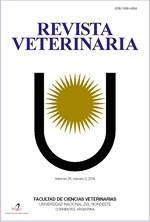Dinámica de la transferencia de inmunoglobulina G en el binomio madre-cría de llamas (Lama glama)
DOI:
https://doi.org/10.30972/vet.3114638Palavras-chave:
Llama (Lama glama), crías, calostro, IgG sérica, placenta epiteliocorialResumo
En las llamas la transferencia de la inmunidad pasiva a través del calostro es un evento crítico para la supervivencia de la cría (teke). El objetivo de este trabajo fue establecer la cinética de la concentración de inmunoglobulina G (IgG) en tekes durante los primeros 5 meses de vida y relacionar la concentración de IgG en suero y calostro de las llamas con la concentración en suero de los tekes. Se diseñó un estudio de cohorte, observacional y analítico. Se estudiaron 25 llamas y sus respectivas crías. Se determinó la concentración de IgG en calostro y suero de las madres y en tekes según una cinética establecida desde el nacimiento hasta los 150 días de vida, empleando la técnica de inmunodifusión radial simple. Los resultados mostraron una concentración media de IgG en suero de llamas de 4311,47 mg/dl y en calostro de 23254,9 mg/dl. En los tekes -a las 0 h posparto- la concentración de IgG fue no dosable, alcanzando valores máximos entre las 18 y 24 h (4094,06 y 4197,95 mg/dl respectivamente) no encontrando en este periodo diferencias con la concentración de la IgG sérica materna (p 0,694). Desde las 24 h hasta los 120 días se observó un descenso en los niveles de IgG (p<0,0001), registrándose un incremento a los 150 días (p 0,0001). Se concluye que los valores de IgG calostral son independientes de la concentración sérica tanto en llamas como en tekes, no existiendo asociación entre los mismos (p<0,0001). El calostro aporta niveles de IgG que en los tekes logran concentraciones séricas similares a las de sus madres a las 24 h posparto.
Downloads
Referências
Al-Busadah KA. 2007. Efficacy of feeding bovine and caprine colostrum to neonatal camel. J Anim Physiol Anim Nutr 6: 5-7.
Bravo PW, Garnica J, Fowler ME. 1997. Immunoglobulin G concentrations in periparturient llamas, alpacas and their crias. Small Rumin Res 26: 145-149.
Caggiano N et al. 2014.Caracterizacion de IgM, IgG total, IgG1 y anticuerpos de cadena pesada en calostro de llamas (Lama glama) mediante Elisa. Rev Complut Ciencias Vet 8: 29-40.
Chávez AR, Sato AS, Navarrete MZ, Cisneros JS. 2010. Anatomía macroscópica de la glándula mamaria de la llama (Lama glama). Rev Inv Vet Perú 21: 1-10.
FAO. 2005. Situación actual de los camélidos sudamericanos en Argentina 46: 1-62. Disponible en: file:///C:/Users/HP/Downloads/41413-56786-2-PB.pdf%0A/http://inf oalpacas.com.pe/wp-content/uploads/2016/08/Perfil-de-fibra.pdf
Flodr H, Wheeler JC, Kruger DP, Olazábal J, Rosadio R. 2012. Pruebas de campo para evaluar calidad calostral en la alpaca. Rev Investig Vet Perú 23: 307-316.
Garmendia AE, McGuire TC. 1987. Mechanism and isotypes involved in passive immunoglobulin transfer to the newborn alpaca (Lama pacos). Am J Vet Res 48: 1465-1471.
Garmendia AE, Palmer G, Martini JC, McGuire TC. 1987. Failure of passive immunoglobulin transfer: a major determinant of mortality in newborn alpacas (Lama pacos). Am J Vet Res 48: 1472-1476.
Lamelas K, Pondé M, Sánchez PM. 2010. Anuario 2010 Subsecretaría de ganadería. Sector camélidos. http://www.produccion-animal.com.ar/produccion_de_came-lidos/camelidos_general/07-CAMELIDOS_miniagri.pdf
Lima A. 2008. Estudo da flutuação sérica de anticorpos maternos nos períodos pré e pós parto e transferência de imunidade passive em cabritos recém nascidos utilizando colostro bovino e caprino. Univ. Sao Paulo. Disertación de Maestría. http://www.teses.usp.br/teses/disponiveis/11/11139/tde-5072008-124634/es.php
Martín C, Pinto C, Cid M. 2014. Camélidos sudamericanos: estado sanitario de sus crías. Rev Complut Ciencias Vet 4: 37-50.
Mangeaud A, Panigo D. 2018. R-Medic. Un programa de análisis estadísticos sencillo e intuitivo. Methodo 3: 18-22.
Medina MA, Fernández F, Saad S, Rebuffi G, Yapur J. 2004. Inmunoglobulinas G de cadenas pesadas en la leche de los camélidos sudamericanos. J Neotrop Mammal 11: 19-26.
Mórtola E, Pennimpede E, Gómez C, Stanchi N. 2004. Transferencia pasiva de la inmunidad pasiva en los animales domésticos. En: Introducción a la inmunobiología, Editorial UN La Plata, Argentina, 653 p.
Pinn TL, Gagliardo LF, Purdy SR, Appleton JA, Stokol T. 2013. Comparison of three immunoglobulin G assays for the diagnosis of failure of passive transfer of immunity in neonatal alpacas. J Vet Diagn Investig 25: 91-98.
Tizard IR. 2009. Inmunidad en el feto y en el recién nacido. En: Introducción a la Inmunología Veterinaria. 8va ed. Barcelona, p. 223-238.
Ratht T et al. 2013. The immunologic functions of the neonatal Fc receptor for IgG. J Clin Immunol 33: 9-17.
Weaver DM et al. 2000. Passive transfer of colostral immunoglobulin G in neonatal llamas and alpacas. Am J Vet Res 61: 738-741.
Weaver DM et al. 2000. Evaluation of assays for determination of passive transfer status in neonatal llamas and alpacas. Am J Vet Res 216: 559-563.
Wernery U. 2001. Camelid immunoglobulins and their importance for the new-born. A review. J Vet Med B 48: 561-568.
Downloads
Publicado
Como Citar
Edição
Seção
Licença
Copyright (c) 2020 J. Auad, J. Cerutti, L. G. Cooper, M. S. Aguilar, A. Lozano

Este trabalho está licenciado sob uma licença Creative Commons Attribution-NonCommercial 4.0 International License.
Política de acceso abierto
Esta revista proporciona un acceso abierto inmediato a su contenido, basado en el principio de que ofrecer al público un acceso libre a las investigaciones ayuda a un mayor intercambio global de conocimiento. La publicación por parte de terceros será autorizada por Revista Veterinaria toda vez que se la reconozca debidamente y en forma explícita como lugar de publicación del original.
Esta obra está bajo una licencia de Creative Commons Reconocimiento-NoComercial 4.0 Internacional (CC BY-NC 4.0)










.jpg)
.jpg)



